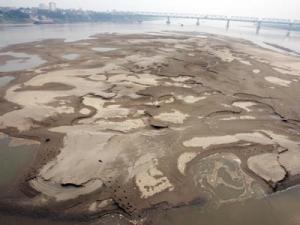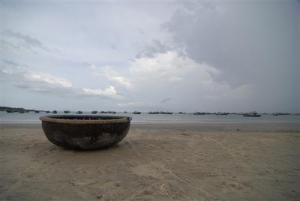Red River becoming no longer red

Scientists have warned that the water of the Red River may be red no more, since the river is gradually losing silt which has been, for many centuries, irrigating the rice fields in the north of Vietnam.
The Red River begins in China's Yunnan province and enters Vietnam at lao Cai Province, forming a portion of the international border between China and Vietnam. Once reaching the lowlands near Viet Tri, the river and its distributaries spread out to form the Red River Delta. The Red River flows past the Vietnamese capital ${bigcity_Hanoi:"Hanoi"}.
The reddish-brown heavily silt-laden water gives the river its name. However, the surveys conducted in the last many years have found out that the silt content has been decreasing, which may cause unpredictable environmental changes.
Silt losing
Trinh Xuan Hoang, MA, a specialist from the Water Resources Planning Institute under the Ministry of Agriculture and Rural Development MARD, said that Red River has been well known as the river with big volumes of silt sediment. However, the volumes of silt have been decreasing significantly since the big reservoirs on the upstream, namely Hoa Binh and Tuyen Quang became operational.
In the period from 1988 to 2008, the average mud and sand sediment concentration in Son Tay city on the Red River decreased to 45 million tons a year, just equal to 38 percent of the total mud and sand sediment seen in the time before the upstream water reservoirs were built. In Hanoi, the total suspended mud and sand sediment decreased to 38 million tons a year, just equal to 51 percent of that before the reservoirs appeared.
“The monitoring data shows that the construction of large reservoirs on the upper reaches is the main cause behind the significant reduction in the levels of mud and sand sediment downstream,” Hoang said.
However, Hoang said that the silt decreases still cannot be recognized with the naked eye. “If people can see with their eyes that the river’s water has become clearer, this would be a great threat to the Red River,” he added.
Scientists call on to re-design dams
According to Dr Dao Trong Tu, former Secretary General of the Vietnam River Network, it is really lucky for the local residents in the Red River delta that silt does not play the prerequisite role in the agriculture development like in Mekong Delta.
In the Mekong Delta, silt has very high quality, and farmers always let silt to flow into the rice fields which allows them to save fertilizer. The silt of the Red River does not tell anything about the quality of the water. Local residents also do not use silt of the Red River instead of fertilizer.
However, the silt concentration decreases will bring bad consequences to the aquaculture. Fishes and shrimps, which have got used to the turbid water environment for many years, will see their living environment changing when the water becomes purer. Besides, silt and specific nutrition contents will disappear, which will lead to the changes of many other factors. As such, the ecological balance on the river will be destroyed.
Dr Tu has warned that if no timely actions are taken right now, the Red River will fall into a bad situation like the Mekong River now: the volume of silt decreases, the cultivated fishes and shrimps also decrease, which has badly affected the lives of people.
According to scientists, hydropower plants all have discharge outlets. However, even with the outlets, a big volume of silt is still blocked. To date, no solution has been found which allows giving back silt to the Red River and other rivers.
“There is only one solution that we need to re-design the discharge outlets for hydropower plants,” Hoang said.
However, this would be a difficult job, because Vietnam is still lacking silt monitoring data. The Ministry of Agriculture and Rural Development only has six measurement stations on the border areas which carry out the measurement only once a month.
Hoang has stressed that it is necessary to reconsider all the impacts of hydropower plants on the living areas, from upstream to downstream, and install more automatic measurement stations which allow to continuously measure the silt levels of the river. The data will help find out the reasons and the solutions to improve the situation









